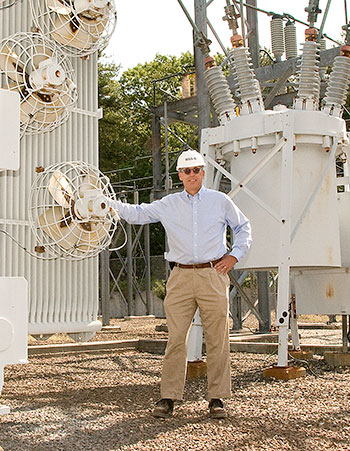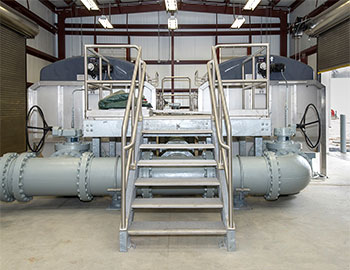Reducing Our Energy and Water Usage
Energy Use
The Laboratory reduces its energy use through programmatic efforts, system retrofits, and new facility designs.
Energy intensity is measured by the number of units of energy used per gross square foot of building space. Since 1973, the Laboratory has reduced its energy intensity by more than half, resulting in significant energy cost savings and reduced emissions.
DOE’s latest goals include a reduction of our energy intensity by another 25 percent by the end of 2025 as compared to 2015. This is in addition to a previous reduction goal of 30% from 2003 to 2015. To that end, the Lab continues to develop and implement energy efficiency projects and energy conservation measures. On October 23, 2013, a Utility Energy Services Contract (UESC) was awarded to National Grid, which included energy conservation measures and infrastructure upgrades to help the Lab meet energy intensity reduction goals.
The first phase of the UESC was completed in May 2015 with the installation of energy efficient lighting and controls in 18 buildings, energy management controls in nine buildings, and a new energy efficient chiller in the Central Chilled Water Facility. Environmental benefits include energy savings of 3,549,114 kWh/year, fuel savings of 89,541 mmBtu/year, greenhouse gas reduction of 7,022 MTCO2e, and an energy intensity reduction of 11 percent. The first full year after the energy conservation measures were installed, the actual energy savings were within 2% of the original estimates.
The phase two of UESC projects has been identified. A preliminary scope has been completed; the next step is a formal Investment Grade Audit (IGA) which will be the basis for a potential UESC Phase II effort. These efforts will make progress toward the new 25% reduction goal.
BNL’s energy management group has installed several new smart electric and chilled water meters to better understand live building energy loads. BNL also conducts energy audits for 25% of the sites buildings on a four year schedule to identify any potential energy reduction measures.With the anticipated growth of staff and facilities, the Laboratory continues to seek out and implement projects to further reduce energy intensity. Examples of these efforts include installing setback capabilities for heating, ventilation, and air-conditioning (HVAC) systems; implementing a steam cost charge-back program that encourages energy conservation by charging building occupants for their use; and conducting energy audits of HVAC systems, lighting, and office equipment to identify further opportunities for energy conservation.

One of the Lab's electrical substations
Water Use
We have a long history of successful water management, reducing our water consumption by more than half since 1999.
Water conservation is a major focus of sustainability efforts at Brookhaven National Laboratory. While water on Long Island is plentiful and inexpensive, here at the Lab it is not taken for granted. The Laboratory’s water management program has been extremely successful, reducing our water consumption by about 55 percent since 1999.
The Laboratory implements water conservation methods and best management practices as much as economically feasible. For example, new construction and renovated buildings at the Lab utilize water-efficient processes and have low-consumption plumbing fixtures installed to conserve water. Our Water Management Plan describes how we design and operate buildings and facilities to be sustainable and water efficient, and outlines our efforts to meet regulatory requirements and reduce water consumption by 2 percent per year.
Water is supplied to the Lab by five groundwater wells. The majority of the Lab's water is used for process cooling at our major scientific facilities. Less than 10 percent of our water is used for human consumption and sanitation. About 80 percent of water consumed by the Lab is returned and recharged to the groundwater at near potable water quality.

Completed in 2014, these final polishing filters at Brookhaven Lab's sewage treatment plant enable the Lab to recycle fully treated effluent directly to groundwater.
Keeping an eye on our energy and water usage
Energy intensity is measured by the number of units of energy used per gross square foot of building space. Since 1973, the Laboratory has reduced its energy intensity by 64%. Our latest goal is to reduce our energy intensity by 25 percent by the end of 2025.
Potable water usage fell from almost 930 million gallons/year in FY 1999 (average of 2.55 million gallons per day) to about 417 million gallons/year in FY 2015 (average of 1.15 million gallons per day), a reduction of 55%.



